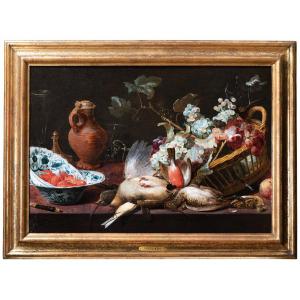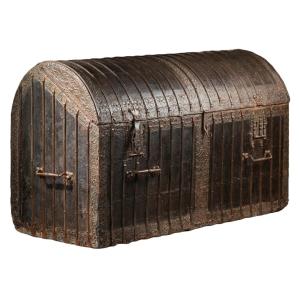Villa Alta de San Ildefonso, Oaxaca, Mexico
Dimensions: h. 32 cm, w. 42 cm, d. 35.5 cm
The cabinet we are presenting is a rare piece, a refined example of Spanish colonial art. Deeply inspired by the work of European cabinetmakers, this cabinet was made in the region of Oaxaca, a production center known for its unique marquetry techniques: wood engraved, incised and filled with "zulaque" (paste made from calcined lime and a vegetable black dye).
The cabinet opens with a flap on the top and a flap on the front revealing five drawers and two drawer fronts. The upper compartment is divided into several spaces probably used to store writing tools. Several secret drawers including three drawers in the lower part and a hidden drawer in the upper part by two fronts. The impressive decor inspired by European engravings and presenting animals, characters in 17th century costumes in vegetal and floral scrolls. The drawer fronts decorated with dogs, hares and hunters in foliage scrolls. The inside of the flap: the heraldic crowned lions and the dogs or foxes on a foliage background. Inside the lid: in the diamond on a background of vegetal foliage, the cherubs are deployed around the Catholic symbols: the mitres and the bishop's croziers, the cardinal's hat as well as in the center two keys of St Peter surmounted by crown papal. In the spandrels, four hunters, two of whom are equipped with harquebuses, move about in foliage surrounded by animals: monkeys, eagles, bulls and lions.
The cabinet has a beautiful ornate silver lock as well as shell-shaped silver pulls.
Thanks to the fame of the craftsmen of Villa Alta de San Ildefonso, all the senior officials of the viceroyalty owned these works as prestigious pieces. Usually when returning to Spain after their services in Mexico, they brought back his objects as souvenirs and testimonies exotic taste. Ecclesiastical symbols in our cabinet may suggest affiliation with a high Catholic dignitary or a gift for a clergyman.
Founded in 1526, Villa Alta was the first Spanish colony in the Sierra Norte de Oaxaca, becoming a veritable commercial, political, economic and cultural enclave during the vireinal (viceregal) era. It is during this period that we see the development of the workshops of the Villa Alta de San Ildefonso de Oaxaca, mixing Mexican know-how with European furniture and motifs.






























 Le Magazine de PROANTIC
Le Magazine de PROANTIC TRÉSORS Magazine
TRÉSORS Magazine Rivista Artiquariato
Rivista Artiquariato
